Add to Flipboard Magazine.
Also read, "Pictures Have Value" on the previous page.
Also read, "Photographers right to photograph in the streets. What the law says."
Copyright is often misunderstood, but is rather simple. It’s the right to make copies
When you buy a book, music download, a painting or signed photograph, you buy just that. You have not become owner of the work itself, but of a copy.
Buying a copy of a work, or even an original painting, does not make you the owner of the intellectual work itself. The artist and owner of the intellectual work continue to own the right to license the work into further copies.
If you have bought a photograph to use in a magazine or in an advertisement, you have bought the right to use it for that purpose.

Photo by Alan Watson, New York 2011: "Yes, Thorsten Overgaard is for sale. For fees, you hire him for personal instruction or join one of his seminars that take place all over the world. Or hire him to come and take amazing pictures for you".
I found it on the internet!
Granted, it is not easy to know what is right and wrong when you find a photo on the internet and Facebook and Instagram are full of images you can like and share.
Look at it like a supermarket where all the things are on display.
It isn't free just because you can see it.
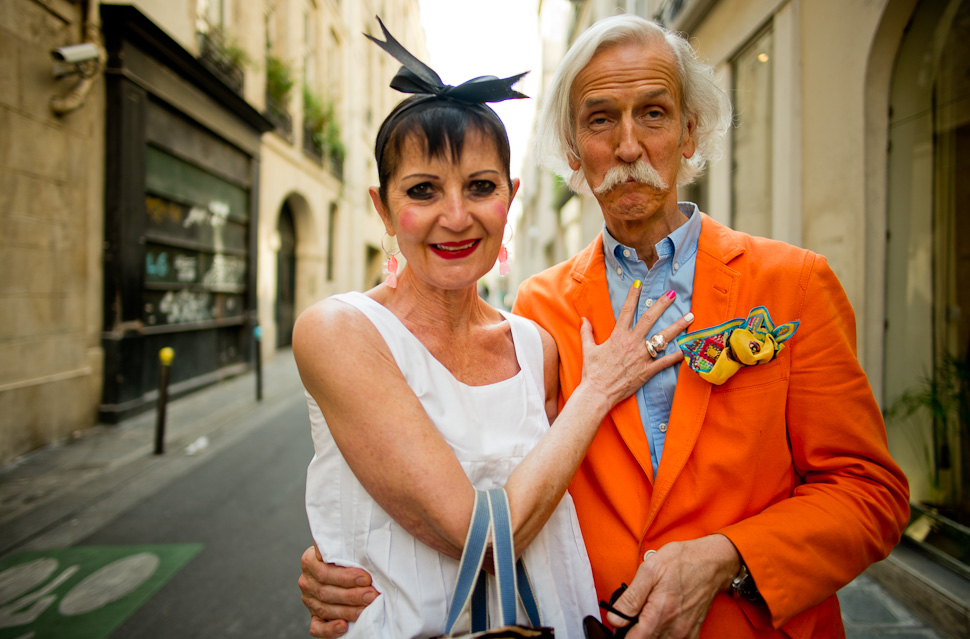
Paris couple. Leica M 240 with Leica 21mm Summilux-M ASPH f/1.4. © 2014-2015 Thorsten Overgaard.
Does Facebook own my pictures?
When people say for example that "Facebook owns your work when you post it", they haven’t read the conditions or have been misguided by rumours. What you allow most social services like Twitter, Facebook, Leica Fotopark, etc. is that you will not sue them when your work is shared within that social network.
The whole point of social network is sharing, so you sign off that is is ok that other users within that social network can share your photographs, videos and other posts.
If and when for example a newspaper takes a photo from your Facebook, Instagram or Twitter account and print it in their newspaper, it is a copyright infringement: You own the work and the fact that you have allowed Facebook to show it within the Facebook.com structure, does not allow anyone to copy your work without asking or paying for it.
In social sharing where you share a link to a post on Facebook, you are sharing the actual Facebook structure (which “holds” the picture).
“Deep linking” is when a website, newspaper website or other link to the actual image on your server and show it on their page as if it is on their page. This is in fact copying your work, even it is the original file on for example your website they show: But they show it as if it was any other photo on their website.
This photo below is linked from my sever to this page, but it could be linked from another site. It would look the same to you:
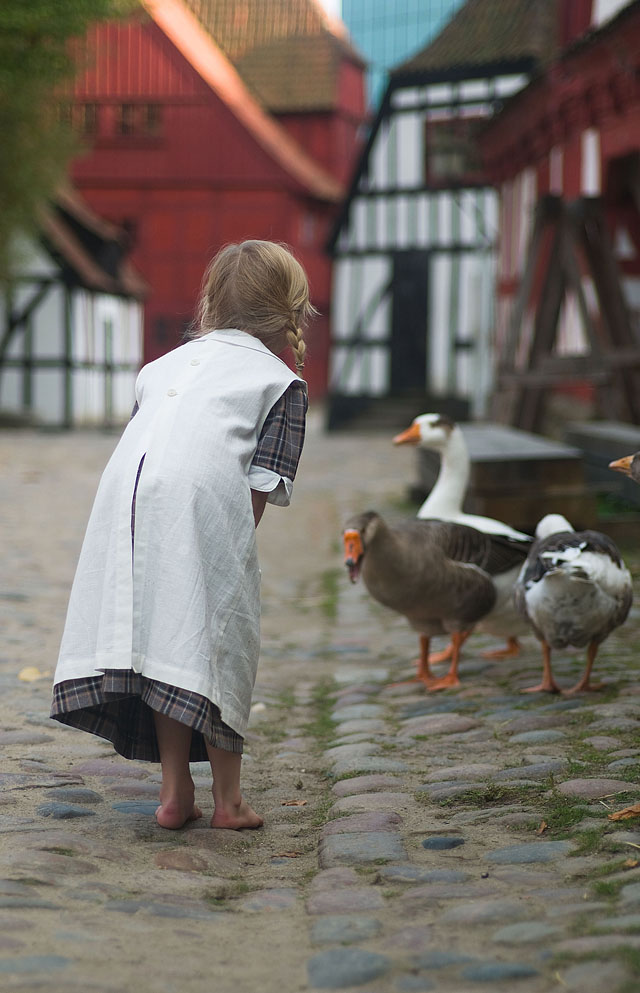
The goose whisperer. My daughter Robin Isabella as a model. Leica M9 with Leica 90 mm Tele-Elmarit f/2.8 (II). © 2007 - 2015 Thorsten Overgaard.
Many news media have “misunderstood” the rules of copyright and think that if they credit or quote Facebook or Twitter as the source, it is ok to take a screen dump, or copy the actual file to their own server and show it on their own website again. But no one is allowed to copy your work other than you who have the copy right (most news media knows but prefer to save money by pretending to be unknowingly of this – but will sue you if you copy their newspaper).
In many countries it is allowed to make a photograph of a person looking at a screen with a picture on it, or to take a pair of hands holding a book or brochure with a photograph on it. In that case - in some countries - you are not copying the photograph, but showing a screen, book, brochure or other with it.
I find it fascinating how many celebrities who could in fact collect a lot of money from gossip pages, tabloids, magazines and newspapers who constantly print their Instagram photos. It's a copyright infringement. Except in the cases where the media "embed" an Instagram photo on their website so that the readers can "follow" the person and/or "like" the photograph. That's is within the sharing agreement you sign when you join Instagram.
But the idea that you can use anything that has been published is outright wrong.
This photo below for example is shared on this page by embedding it from my Instagram account, so that is allowed by anyone to do. I didn't make a copy to share it:

Daily Mail is one of the media that consistently steal (as in hundreds by the day) other people's photos and credit the persons Instragram, like this Beyonce's photo. What does "© beyonce/ Instagram" mean? Well, it means, "We stole this off Instagram and pretend it's legal". In actual fact, it is © Beyonce and she can send an invoice as contributor. Now, why don't they simply embed the Instagram photo? Of course, by copying other's content to their own server, Daily Mail can make sure they don't end up with empty spots if people remove their photos. But more relevant is it that it keeps the traffic on the Daily Mail website. They even have the nerve to add sharing links so you can share their stolen copy (not Beyones's original post on Instagram), to other social media. You bill them, and they will pay. They have to, because that is the law. They may be criminal, but they have real lawyers working for them. But in a media house that pays sources to create new stories, and steal content, the few payments are a better deal than paying for all of them. My estimate is that they commit copyright infringement for +$100,000 a day, which is about 300 photos day. Not much in the overall business of Associated Newspapers Ltd (DMG Media) which is oabout 1 billion USD a year, but it goes with the criminal mind you must have, to run a business like this.
Copyright on digital download and intellectual property (ideas, patents, poems, etc) is not much different from buying a chair. You can buy a chair and you can let your friends sit in it, but you cannot make a copy of the chair, and you can most certainly not start copying the chair to sell it to third part!
Social media as promotion
Some photographers don't want to post pictures online out of fear that they will be stolen. But it follows the rules as described above. Facebook doesn't take over the rights, and if and when somebody copy your work, you can send them an invoice.
I spend some time every year collecting payments for copyright infringement. It's a great indoor sport and it pays well (see my previous article "Photographs have value").
For me social media is a promotional tool. It is a way to show your work to a larger audience amongst whom there will be future fans that will buy your prints, books, etc - as well as editors or marketing directors who will commission you.
Many photographers had Flash website's made (and many still does, actually) because you cannot copy an image off a Flash website that easily. But Flash website's are slow, complicated to update, and most importantly they are invisible to Google. They are from a time where people visited a website and followed the structure down through that page. Today most of the website traffic comes from Google and enters the page on a sub-page, often a page that was found because of a few words in the text or attached to an image.

Sunset Boulevard, Los Angeles, August 2015. Leica M 240 with Leica 28mm Summilux-M ASPH f/1.4.
© 2015 Thorsten Overgaard. Lightroom 6 with 2010 Process.
How to report copyright infringement on Twitter
Twitter respects copyright, and if some of your works has been used on Twitter and you want it removed, you can go to this Twitter Supoort page and report it.
"Own your masters, slaves!"
As a photographer you should always own your own photographs. In my opinion. Put yourself in a position where you only work on the condition that the photographs are your property. Live to take photographs rather than to make money by keeping your living costs at a level so you are independent and don't "have to say yes".
In the music industry it is very common that when you sign with a label, you sign off the right to your masters (recordings). This is what made Prince write "Slave" on the side of his face and fight his record label for years, and if you watch a documentary like "Artifact" you will realize that even an artist sign with a record label and get supposedly millions, the artist often end up owing the record label money after a series of successfully records. It's very unjust deals being offered, even it looks glamorous from the outside.
Some artists like Jay-Z managed to buy back his masters, others like Michael Jackson even bought others too (The Beatles), but generally people are unaware how valuable it is to own the rights to ones own work till it is too late.
Jay-Z is the one who said, "Own your masters, slaves!" and emphasises the relief it is that you as an artist can pass your work on to your kids.
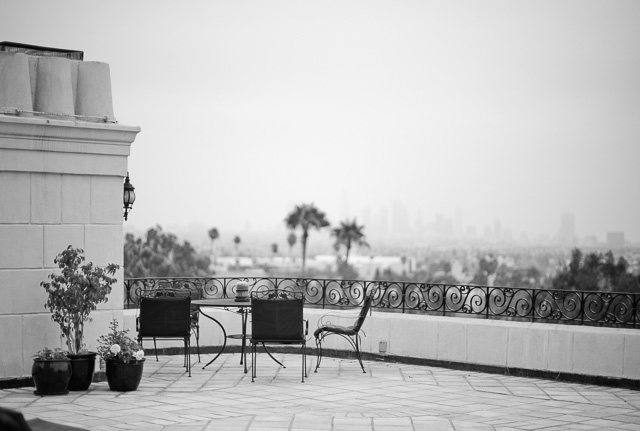
My new morning ritual in Hollywood is to go on the rooftop before the sun starts to heat up the city. Here I read a chapter or two in my Jay-Z bible Decoded while zipping coffee with a view to the Capitol Records building. Leica M 246 with Leica 75mm Summilux-M f/1.4
Own your photographs
Traditionally photojournalists working for a newspaper have owned the rights to their own work and used to be paid for every use. Today photojournalists are often faced with contracts where a chain of newspapers have the right to use their photos for a period without paying additionally for it (other than the photographers salary as a hired staff photographer).
As an employee or contributor to many of todays media houses, the make yiu sign that they own the copyright of what you make, yor archives, notes and everything related to what you do for them. If you want to remain the owner of your own work, you have to be freelance.
It is different from the old days, but it is not much different from working for most companies where what you make is theirs. Though if you are for example an inventor and invent a machine or something, you will own the patent for that.
I still feel it is important and right to own your own photographs. But that is a choice you must make. You want the comfort of getting a steady income and know what you got, or would ypu prefer to be freelance and know with yourself that you will always make more that way?
Some photo agencies like Getty Images hire photographers free-lance on a "half a day rate" or "day rate" and own the copyright for everything the photographer makes(!).
| |
|
|
| |
"Intellectual property is the oil of the twenty-first century"
- Mark Getty
(Oil fortune heir, founder of Getty Images 1995)
|
|
| |
|
|
I always made it a point that I own my own work. When I am hired by a client to photograph a series of photos somewhere in the world, what the client pay for is the usage right of the photographs, not the actual photographs. Generally I will allow "any use in own publications for unlimited time period" which allow them to use it on their own website(s), brochures, magazines, etc as much as they like. But not selling the photos or allow others to use them.

Andreas Rusch on the Overgaard Workshop in Berlin. Leica M 246 Monochrom with Leica 50mm Noctilux-M ASPH f/0.95
Some times the rights will be extended so that "any third party may use the photographs for free as long as the context is the clients product or business". This allow my client to use the photographs for PR, but limits a newspapers right to use the photographs only in that context where it is PR for my client. They cannot use the photographs in any other context. Unless they pay for the use to me.
Other clients like the UN I have photographed for where they have the right to use the pictures in their press library for anything for three years, including offering them for free to any media or organization that want to use them. During that period I can still sell the photos, and after the three year period any use has to be cleared/paid for.
In all the cases, the photographs are mine and remain mine. The client, even they commission the work and pay a fee and expenses for travel, buy the right to usage.
The client can never sell your photographs as if they were their own.
When I worked for WireImage who was bought by Getty Images, I was free-lance. My photographs were mine, and WireImage would sell them and get a percentage. When Getty Images took over WireImage, the photographers working for WireImage continued on those conditions.

American actress Anne Archer, October 2010. Leica M9 with 90mm Summarit-M f/2.5. © 2010-2015 Thorsten Overgaard
But Getty Images generally can only handle their photo archive as if it is their own (as far as editorial and entertainment is concerned). So they had some trouble finding the right leg to stand on. With them I worked out a interesting split: Some events that Getty Images would like me to cover on a "day rate" (and I wouldn't), we set up so that I covered them as free-lance for WireImage and at the same time was hired by Getty Images to photograph the same event for them. I would take photos of for example actors and directors attending the European Film Festival, and when editing the photographs I would have to make sure to divide the photographs evenly between myself and Getty Images so we both got equally important photographs.
There was a few interesting situations with an editor calling from London yelling how I dared not giving them a certain photo. Thing was that both "my" WireImage photographs and "their" Getty Images" photographs would be online on the same website, so magazines could buy whichever they liked the best. They would see the selling value clearer than I would, I would usually sort them after quality.

British actress Judi Dench receives an honorary LIFETIME ACHIEVEMENT AWARD at European Film Awards at Forum on December 6, 2008 in Copenhagen, Denmark. © 2008-2015 Thorsten Overgaard. Leica R8 DMR with Leica 35-70mm Vario-Elmarit-R ASPH f/2.8.
When Getty Images asked for "day rate" I knew it would be valuable photographs. That was why they wanted to pay a limited fee and make sure they could harvest the rights over a number of years. I eventually quit working for them and my archive is mine and I have it myself. If you go online on Getty Images, the images by me you will see are their "half" from the events where they paid day-rate for their half of my photographs.
In some cases, when you are hired to do a portrait, you don't have the right to the photograph. Or you may have the right to the photograph, but not the right to publish it. It differs from country to country, some times from agreement to agreement. This is also the reason some find that they hired a wedding photographer but don't have the rights to their own wedding photographs.
It's a detail worth checking out. You could also have the rights to family portraits taken, but the photo studio happens to have the negatives!
| |
|
|
|
|
| |
Buy the new eBook
"A Little Book on Photography"
by Thorsten von Overgaard |
|
| |
|
|
|
|
| |

Order now - Instant delivery.
More info
★
★
★
★
★
★ |
|
It's a humorous understatement to call this
new eBook by Thorsten Overgaard for
"A Little Book on Photography".
It's a grand book, a history lesson, life experience, a biography and poetry book and brilliant photo book!
All in one beautiful package of 180 pages
to fire you up and get you to love
photography ... unconditionally!
"A Little Book on Photography"
eBook for computer, Kindle and iPad.
New release March 2017.
Intro price only $47 - 180 pages.
| |
|
|
| |
Buy Now

Instant Delivery |
|
| |
|
|

|
|
| |
|
|
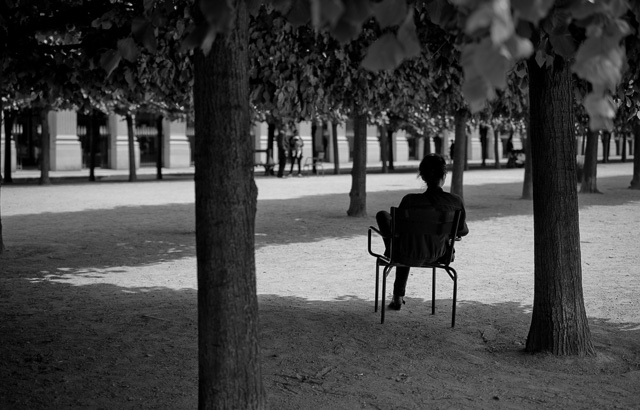
Leica M 246 with Leica 50mm APO-Summicron-M ASPH f/2.0. © 2015 Thorsten Overgaard.
Buying photographs
If you have bought a photograph to use in a magazine or in an advertisement, you have bought the right to use it for that purpose.
The price is usually calculated for that specific use (based on size, circulation and the period of use). You can buy the right to use a photograph online for a three month period for $50 from Getty Images, or you can buy the right to print a photograph in a newspaper for $120.
The calculation what it cost to use a photograph is simply how much you use it.
There are three classifications of use of photographs:
1) Commercial use, which is where photographs are used in ads, television commercials and such to promote products. Election posters for political parties and candidates fall under this as well, decorative walls in stores made from a photograph, t-shirts using a photograph, etc; basically any use of a copyrighted work "to sell" something "or make a commercial product" is commercial use (no matter if the commercial use is making money or not). Mostly those types of photographs are commissioned but an advertiser could also find a picture to use and the calculation of the price for use will be higher than any other use.
2) Non-commercial use is any use that is not advertising and is the most common use of photographs. It is paid for. This is editorial use of photographs in blogs and newspapers, in books, television news, etc. Whilst "non-commercial" use may sound as a free ride, it is not. Any non-commercial use of photographs are something you have to pay for and is the most common use of photographs.
2.1) A sub-category of non-commercial use that you don't usually find in the price lists is a photograph licence for a movie or television series (on a wall or somehow appear on the screen), using a photograph in a slide show on a screen in a store or in an airport, etc.
3) Fair Use is basically the right to quote a small part of something, but is often misunderstood as a right to use anything if you don't make money on it. In the United States copyright law, fair use is a doctrine that permits limited use of copyrighted material without acquiring permission from the rights holder. It's almost impossible to "quote a photograph" so fair use of photographs is not really possible.
Creating a painting based on a photograph, or creating a collage that includes parts of a photograph, is still not within Fair Use. In a court case they would apply a four-factor balancing test to determine if it is fair use: 1) the purpose and character of the use, including whether such use is of a commercial nature or is for nonprofit educational purposes; 2) the nature of the copyrighted work; 3) the amount and substantiality of the portion used in relation to the copyrighted work as a whole; and 4) the effect of the use upon the potential market for or value of the copyrighted work.
Model releases and copyright?
See next page for my article "A note on model releases for people in photographs" (available later).
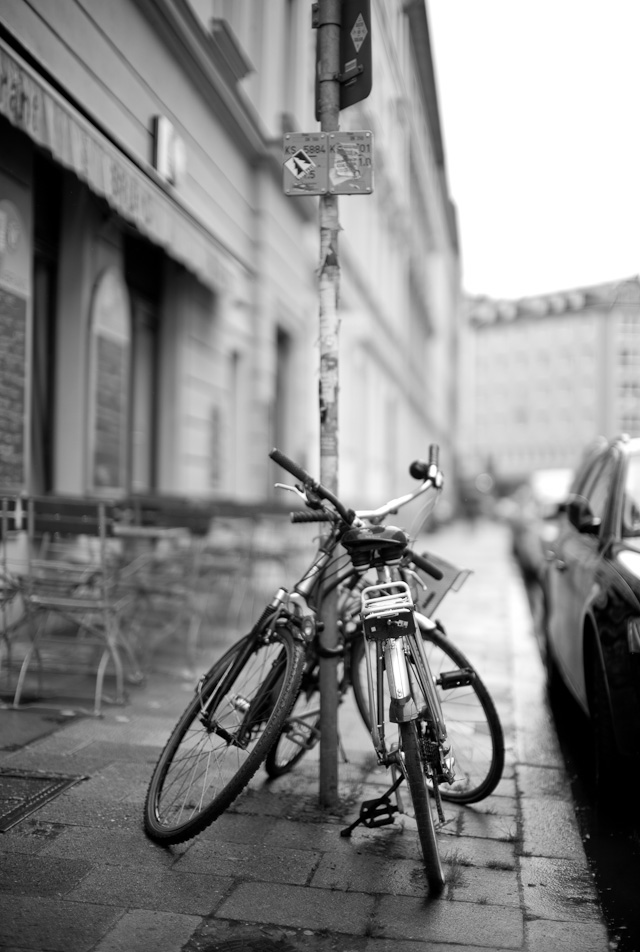
Bicycle-kiss in the rain of Berlin. 400 ISO. Leica M 246 Monochrom with Leica 50mm Noctilux-M ASPH f/0.95. © 2015 Thorsten Overgaard.
How do I get copyright?
You don't get copyright. You have copyright on anything you create the moment you do so.
It is often misunderstood that you have to go to an office and register your rights. It is correct that in the US there exists an office for copyright (United States Copyright Office), but this is how it goes: You have the copyright, and in case someone violate it, you go to the office and register your copyrighted work(s) so as to make it easier to fight it in court.
It's not that if you "forgot" to register a work, you don't own the copyright. Likewise nobody else can register your work as theirs. In an analogy you could say the copyright office is issuing you a passport. You are always you, but it's easier to travel to other countries if you have a passport documenting that you are you. So if you have to travel to a court, the copyright office issue the "passport" that shows that you are the owner of it. "Copyright registration" is to place on record a verifiable account of the date and content of the work in question, so that in the event of a legal claim, or case of infringement or plagiarism, the copyright owner can produce a copy of the work from an official government source.
You don't have to write on a photograph or in a book that it is copyrighted to have your copyright. It was yours from the moment you created it.
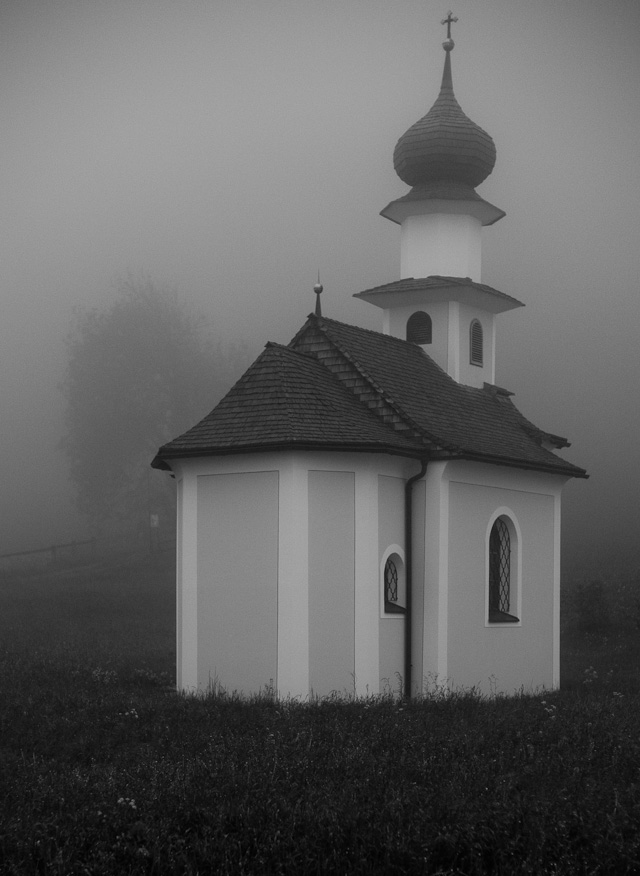
On my way from Italy to Germany I stopped for the night on a hillside in Austria. The sun was going down and the mist came down the mountains. Opposite the hotel was this small church building that looked as if the owner had decided to built a church for just one person. 3200 ISO. Leica M 246 Monochrom with Leica 50mm Noctilux-M ASPH f/0.95
You don't have to be somebody of importance to own your work
Another misunderstanding is that you have to be somebody or a professional photographer to have copyright. You don't. It doesn't matter if you are a housewife, a four-year-old or a professional photographer. If you made the photo it is yours and it is copyrighted the moment you made it.
Likewise, it doesn't matter if you made the photograph with an iPhone or a large expensive camera. It's a photograph.
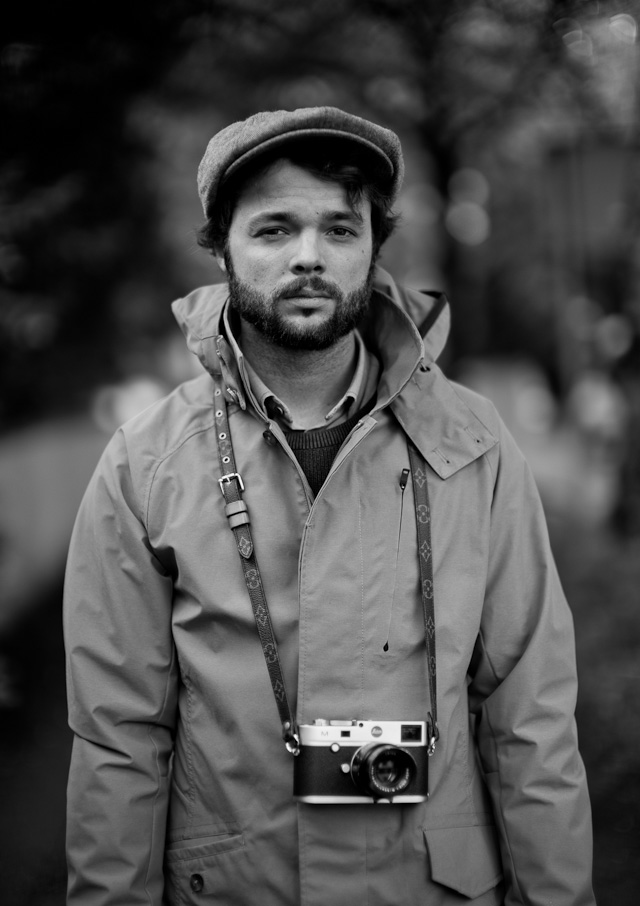
David Innerhofer from Austria at the Overgaard Workshop in Munich. 400 ISO. Leica M 246 Monochrom with Leica 50mm Noctilux-M ASPH f/0.95
 |
NEW VERSION 11.3 |
 |
| |
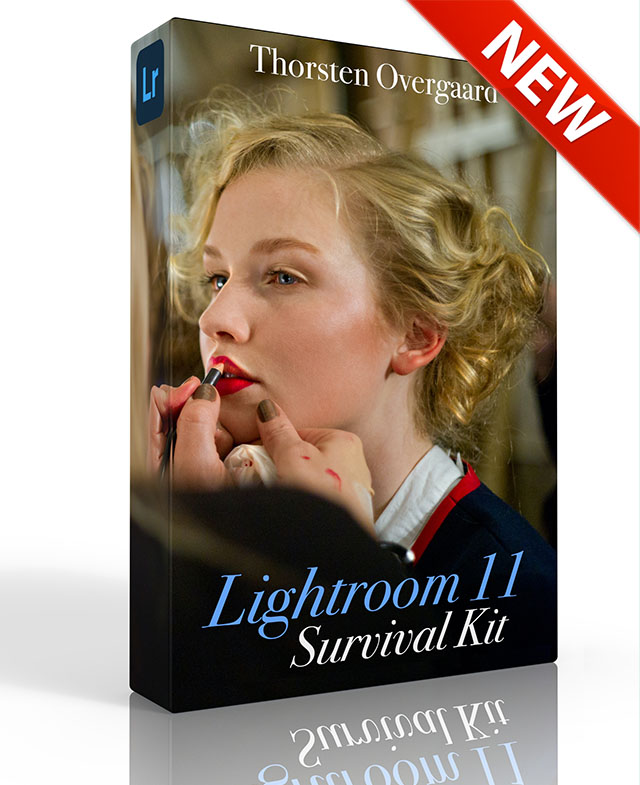 |
|
| |
|
| |
|
|
|
|
| |
|
| |
|
|
| |
Buy Now. Instant delivery.
New Version 11.3
ONLY $698.00

Now includes
4+ hours of
video tutorials.
100% satisfaction
or 100% refund.
More info.
|
|
| |
#2130-1121-3 |
|
| |
|
|
| |
Update to Version 11.3
Apply
code "UPDATE113" on checkout to get this complete version 11.3 update.
$298.00

Updates all previous Surival Kit versions since 2009. |
|
| |
|
|
Buy the complete new
Lightroom Survival Kit 11.3
The Legendary Tutorial for Photographers
Brand-new JUNE 2022-version.
Now with brand-new 4+ hours of video tutorials.
New sections on compostition and storytelling.
How to edit color photos.
How to edit black & white photos.
How to do keywords logical and easy.
The most successful photo editing kit ever
Photographer Thorsten Overgaard first released the Lightroom Survival Kit in 2009 and have honed it with new and fresh updates. This Version 11 is the most radical updated and renewed version ever, four years in the making.
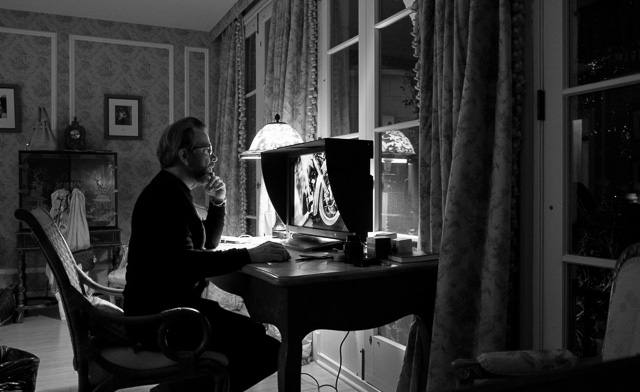
Professional workflow experience made simple, logical and easy to use.
Master editor makes it simple to understand
The Survival Kit is unique and one-of-a-kind being made for photographers for photographers. When someone understands their subject, they can explain it so it is easy to understand. The hallmark of Thorsten Overgaard is to make expert knowledge shown and told in a way so anyone can apply it.
Hands-on advice that works
With a 450 pages workbook and 4+ hours of video, every element of digital photography is touched on, in handy chapters and pre-flight checklists. Editing of color vs black and white photos, keywording, cropping of images, fine-tuning of tones, color balance and color control, export of originals, printing, archiving and backup, and much more.
Comes with the Overgaard Leica Presets (Value $48)
The Lightroom Survival Kit comes with Thorsten Overgaard's special-made Lightroom Presets for all digital cameras and for Leica digital cameras.
Understand all from camera to the final print
Chapters in this version goes over the background for High Dynamic Range (HDR), digital raw files and how to set up a professional photography workflow, from calibrating the screen to editing in Lightroom, and to making a final print. And more ...
10+ years experience in one package
No need to spend years figuring out the smartest way to do things when you can tap into the best way of doing things right here. The workflow of Thorsten Overgaard as been refined through years of field work with more than a thousand workshop attendees.
This method of workflow now used by thousands
The Survival Kit has been taught to thousands in workshops and in this Survival Kit. What does it do? It make you enjoy taking and making photos, and it increases your production considerabely. Most important of all, it'll give you back ownership of your files (which you will understand why is so important, once you have bought the Survival Kit and started applying its methods).
| |
|
|
| |
"Thorsten's methodology is perhaps not what hardware-, software- and cloud-companies want us to do, but as a former IT engineer I can only acknowledge his views about preserving our digital heritage. This workflow explained is for me the best I have ever seen".
★★★★★ |
|
| |
|
|
Video tutorials, image files, presets, checklists, definitions, tutorials of Lightroom, that boils down years of experience to a workflow you can implement in less than one day.
Start working in minutes. |
|
|
| |
|
| |
|
| |
|
| |
|
| |
|
| |
|
|
|
|
 |
|
 |
How long does Copyright last?
In the US the copyright remains with the maker of the work for 70 years after his death. After that it is public domain.
The US copyright laws over time:
1790 law: 14 years + 14 years renewal period.
1831 act: 42 years.
1909 act: 48 years. (coporate copyright 56 years).
1976 act: 50 years after the death of the maker (corporate copyright 75 years after first publication)
1998 act: 70 years after the death of the maker (anonymous work and corporate copyright 95 years after first publication.)
Thanks to Mickey Mouse it's likely that the American copyright law will see a new act before the copyright on Mickey Mouse runs out in 2017.
I Denmark the copyright used to be 50 years from the time of the artists dead, but was changed in 1996 to 70 years. In that process, all previous works also got their copyright extended to 70 years after the makers death.
In my opinion, copyright should not be time limited. Imagine if you built a house, and then when you died and your kids took it over, 70 years laterd, they had to move from the house because it was now public domain? As little as that would make sense, as little does it make sense to have a time limit on copyright.
There are arguments that for the "public interest", copyright should end and works should be free. It sounds great, but what does it mean? That milk, gazoline, housing, coffee, movie tickets and airline tickets should eb free also, esrving "public interest".
It's very easy. If you make something, you want to keep it. If you invested time, talent and resources in making something, you want to make money on it. Only if you never made anything you would get the idea that what others made should be free to you.
So if I give my pictures to you for free, are you going to do my garden work for free and put new tires on my car for free? If that's the case, then let's talk. But till then, leave my pictures alone please.
Copyright also covers motion pictures or example, meaning that a motion picture becomes public domain at some point. In the celloid film days, at least you could hold on to your film cans of film and it would be pretty hard for others to make copies. But in the age of digital film, public domain easily becomes just that: Public domain.
Obviously, governments must work on ensuring the right to own your own work, as well as strengthen the possibilities to make sure your property is not stolen.
How do I transfer copyright?
When you die, your kids would take over the rights.
You may also transfer the ownership rights of copyrighted work by a written and signed document.
The other side - The user viewpoint
On this page you can read a "copyright victim" post where The Content Factory warn against being the "victim of lawyers and photographers who want money for their photographs". They had to pay $3,000 for stealing a photograph. They complain "he wasn't a real photographer" and that "he wasn't that well known", and their own post where they used the photograph "was only visited by 100 people", and the "photo wasn't a good photo" in any case. Yet they used it, but even that wasn't their fault.

Leica M 246 with Leica 50mm APO-Summicron-M ASPH f/2.0. © 2015 Thorsten Overgaard.
I can sympathize with having to deal with lawyers who always act as third part to dramatize things so as to make two parties invest a lot of time and money in being right. That's the business plan of lawyers. Often things could be solved quietly and in understanding. I for example never have to use lawyers to settle copyright infringements, but if I stumbled into someone so dumb they just don't want to follow the law, I will throw dollars after it by hiring the most annoying lawyer I could find. You sue people till they change their ways.
One of the things that seem hard to understand is that a photographer has to be paid for something he already did. How did the photographer loose money on an image being stolen when it was already there doing nothing? That of course is justifications for using something that is not yours.
There is also an interesting article here at stockphotorights.com: What you need to know" that goes over copyright from the user viewpoint.
A 12-page document briefing from the European Parliament as of June 2015 gives the history of copyright and the curent status and considerations, "The challenges of copyright in the EU".
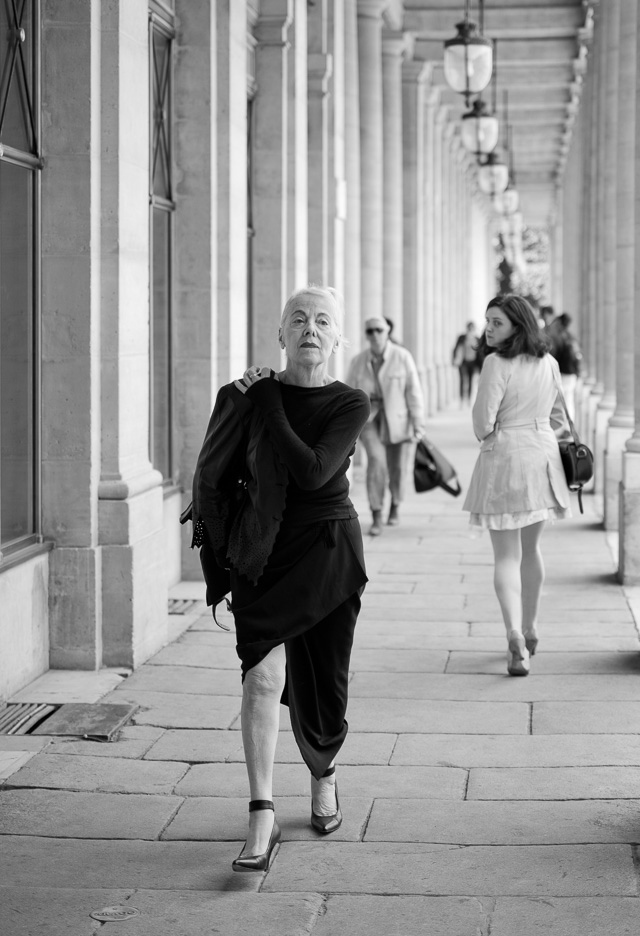
"Déjà vu". Leica M 246 with Leica 50mm APO-Summicron-M ASPH f/2.0. © 2015 Thorsten Overgaard.
I hope you enjoyed today's Story Behind That Picture and it made you think about the value of your photographs in more than one sense, as well as your responsibility to create them, preserve them and make them available.
As you may have noticed, this article is part in a little series I am doing on value of photographs, rights, model releases, maintaining an archive and protecting it. I will post an overview of the articles when they are all available.
As always, feel free to mail me at thorsten@overgaard.dk with comments, suggestions and questions.
Links
European Parliament document on Copyright in the European Union and Worldwide: "The challenges of copyright in the EU" (12 page PDF as of June 2015).
A few intersting case studies on how to make it right
Ming Thein experienced to have Flickr remove some of his images after a watch company claimed they owned the pcitures: As it turned out, the watch company had hired a company to watch out for copies of their watches and that company claimed to Flickr that the images were a copyright infringement, and Flickr acted on it immediately. But two days later Flickr changed their mind after some social media warfare, and the watch company also went into the matter and excused. It's an interesting case because Flickr is supposed to - you would think - wprk for and with photographers, and also to know the basics of copyright. It's the one behind the camera and not in front of it that owns an image.
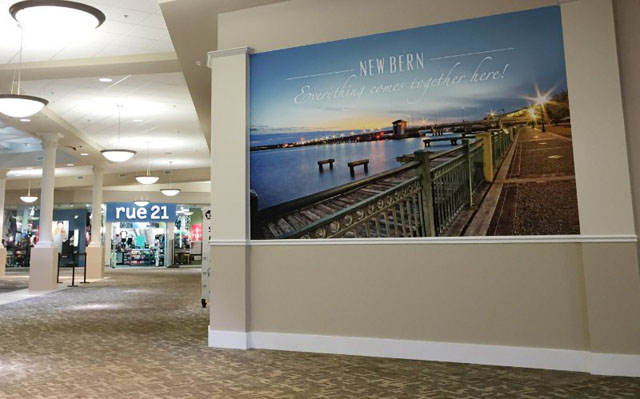
Hull Property had problems with the word "property". They thought you could just take somebody elses pictures, blow them up and hang them in their malls.
"Hull Property Group Stole My Photo" is the stroy of Zach Frailey who saw his image used as a poster in the local mall and called the Hull Property (James M. Hull) who said they always google images and use the ones without watermark, without paying. They ended up paying and this is the story on how.

My picure of Prince was used on more than 10 website without permission. © Thorsten Overgaard.
When Prince died in April 2016, I looked up if anyone had used my photos of him. I found more than 10 pages that had! Some had used it since 2014. So I invoiced them for the use, plus the normal +100% fee for copyright infringement.
One of the websites that had stolen the picture, www.izismile.com, has a note on their website saying that "All the pictures, videos and games contained on izismile.com were collected from different public sources, including different websites, considered to be in public domain." which indicates that they think that if something is visible, you can take it. They further write, "Izismile.com makes every attempt possible to source the artist or photographer, but sometimes cannot find the exact information. We respect the work of others, that is why we always try to put a link to the source where images were found. The links of the sites that own author’s rights and/or public domains where the content was collected are indicated above each post right before the comment section."
Now, this website www.izismile.com sells ads, but they expect to be able to present content made by others, without paying for it. Commcerce doesn't work that way. You steal others content to attract traffic so you can sell ads based on that traffic.
Another website that seems to deal with copyright infringement on a daily basis, is ebaumsworld.com who have a e-mail to contact if one's material has been abused. They spend a whole long page explainingall the things you as the offended has to provide for them to take down your material! This website that has more than 19 million monthly visitors is owned by Viumbe, LCC in San Francisco who also runs Celebremix and Your Daily Media.
A website in Netherlands, prutsfm.nl credit "Foto's: businessinsider.com" as source for the pictures. As if crediting where you copied them from make you not have to pay for use.
A website in Belgium, hln.be, has been using two of my photos of Prince for more than two years. What's interesting about this website is that it's owned by De Persgroep Digital that owns about 40% of Danish newspapers as well - naturally - a lot of Belgiums newspaper medias, television and websites. They did pay my invoice for usage of my photographs.
What I often find is that well-established corporations does copyright infringement, just because they do. The formal procedures for acquiring photographs are not always followed. When pointed out, they usually make it right and pay. You just send an invoice via the formal lines, and they will eventually figure it out internally and get the invoice approved and sent for payment. Don't go ballistic or start a social media war, just send them an invoice.
Here's some of the website that used my photos without permission: Daily Mail, oddpad.com, cracktwo.com, thechive.com, prutsfm.nl, primefortune.co, Het Laatste Nieuws hln.be, flavorwire.com,
Also read, "Pictures Have Value" on the previous page.
![]()
